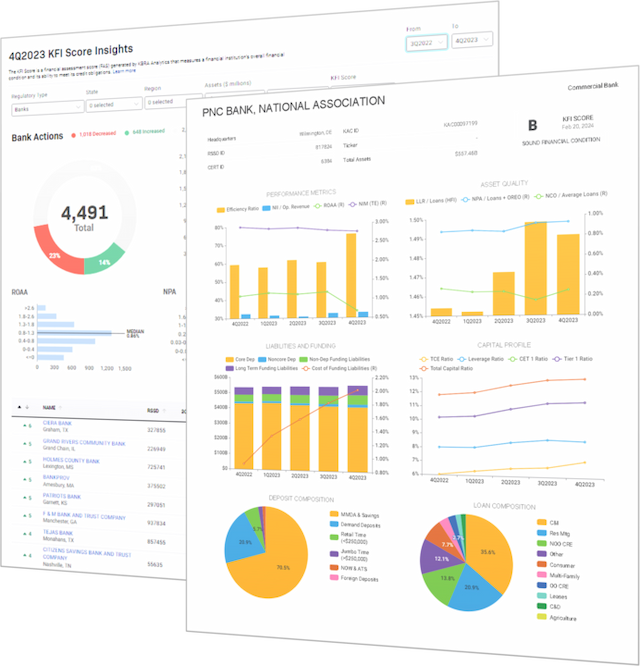KBRA Financial Intelligence
Mortgage Rate Tumble Yet to Revive Purchase Volume; Outstanding Residential Loans Remain Historically Healthy
By KFI Staff
By the end of August, the average rate on 30-year fixed mortgages tracked by Freddie Mac’s Primary Mortgage Market Survey had fallen more than 144 bps from a more than two-decade high of 7.79% last October. This marked the steepest decline in any 10-month span since the period from July 2008 to May 2009. Within that time frame, the Federal Reserve had implemented three rate cuts, reducing its benchmark overnight rate by a total of 175 bps. Though a more measured cut to rates (likely 25 bps) is expected for this month’s Federal Open Market Committee (FOMC) meeting, the precipitous drop in long-term rates on mortgages and other lending products has preceded a formal start to monetary easing. KBRA Financial Intelligence (KFI) took note of traders aggressively front running the central bank at the long end of the yield curve last month, highlighting the resulting compression of U.S. banks’ net interest margins (NIM).

Depending on the new policy path that Fed officials lay out on September 18, it is possible that the ongoing tumble in mortgage rates maintains its aggressive pace. The ongoing downshift in rates has not yet prompted gauges of mortgage originations to reverse course. Data from the Philadelphia Federal Reserve Bank’s latest FR Y-14M release indicates that both the number of new originations and the dollar value of those accounts among large U.S. banks reached series lows in 1Q 2024. That was in spite of the quarter-over-quarter change in the average 30-year mortgage rate exhibiting a modest 10-bp retracement.
The average rate on 30-year mortgages has exceeded the 6.0% threshold for two years now, yet Redfin notes that most outstanding U.S. mortgages were locked in below 4.0% by 1Q 2024. Moreover, although its majority has shrunk from a record 65.3% at the start of 2022, the sub-4.0% grouping still represents 57.4% of all mortgage loans. The mismatch between rates held by existing homeowners and the current market rate to originate a new mortgage presents a difficult prospect for home sales growth, as many potential home sellers will be hesitant to effectively trade in their low rate for a higher rate tied to whatever dwelling they move into next. Further, supply-side tightness constrains the inventory of homes, keeping price growth robust, thereby pricing an increasing portion of would-be buyers out of the market.

The good news for many banks, however, is that residential mortgages are generally in good standing. Fed data shows that the rate of delinquency among single-family residential mortgages was historically low at 1.73% in 2Q 2024—more than 40 bps below its five-year moving average. That has ticked up a few bps over the past couple of quarters, but the dollar value of residential mortgages in delinquency fell to the lowest figure in a year throughout 2Q. This has been an especially welcome development for banks with a significant share of their lending business concentrated in the mortgage segment. The exceptionally low level of stress in residential mortgage loans stands in stark contrast to lending secured by commercial real estate (CRE). The delinquency rate tied to commercial properties (excluding farmland) has nearly doubled throughout the past two years, recently reaching a more than nine-year high.
Among a cohort of 31 U.S. banks reporting more than $10 billion in residential mortgage lending in 2Q 2024, Charles Schwab Bank (KFI Score: A)–the largest subsidiary of the Charles Schwab Corporation–stands out as having a particularly sizable mortgage lending business relative to its total lending. Single-family residential mortgages represent $26.9 billion of its loans, equivalent to 64.7% of the bank’s entire loan book. Data compiled by KFI indicates the delinquency rate among Schwab’s mortgages is calculated at just 0.2%, the lowest rate among all banks in the observed cohort. At the other end of the spectrum, MidFirst Bank (KFI Score: B+) has also concentrated nearly two-thirds of its total lending within residential mortgages, but more than one-quarter of these $19.9 billion of mortgage loans has fallen into delinquency. Also of note are Bank of America California, National Association (KFI Score: A-) and Bank of America, National Association (KFI Score: B). These two banks share a parent organization (Bank of America Corp.) and collectively hold $253.6 billion in mortgage loans, carrying delinquency rates of just 1.31% and 1.59%, respectively. Individual banks and credit unions can be sorted by the delinquency rate of various loan categories using the Data Wizard in KFI’s Excel plug-in, as well as the Loan Category and Delinquency Report template from our Template Library. To access our full library of tables and templates, request a demo with KFI.

While lower rates will certainly depress the interest income banks are raking in from the relatively expensive mortgages that they have been able to lock homebuyers into over the past couple of years, the volume of sales could stand to rebound from subdued levels. Though mortgage rates have given up a significant amount of ground already, the available data has yet to show a comparable rebound in mortgage demand and home sales. Still, it may take some time for such a bounce to materialize as market participants may be prepared to stand by and wait to see just how far rates slump now that the cat is out of the bag on the Fed’s imminent easing. Fed officials have signaled that they will take a moderate approach to the coming rate-cutting regime, but market participants have certainly not forgotten that each of the last two instances of U.S. monetary easing ended up sending the central bank’s benchmark rate crashing toward near-zero levels less than sixteen months on from the first cut—taking long-term rates down with them.
